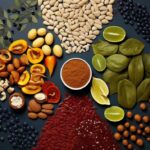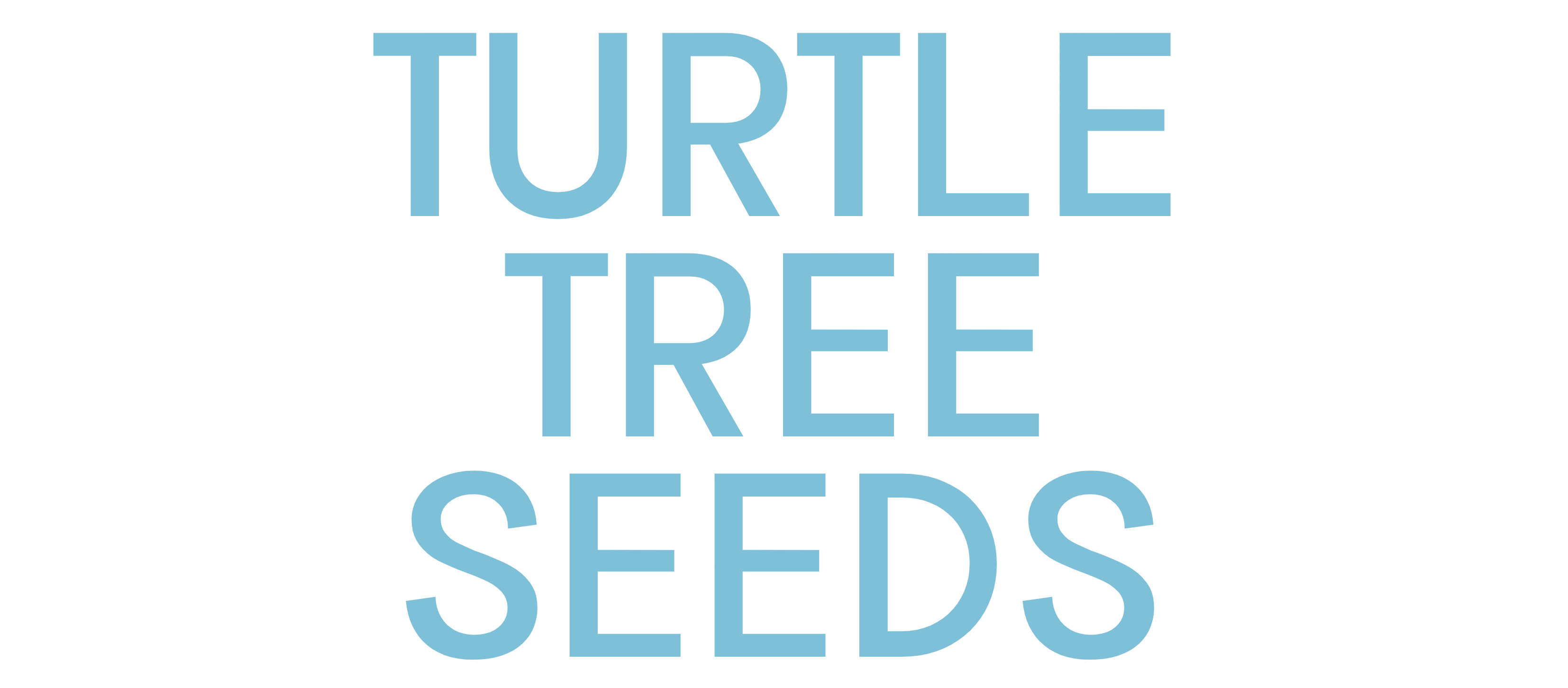Historical Use of Chia Seeds
Seven Historical Uses of Mayan and Aztec Seeds

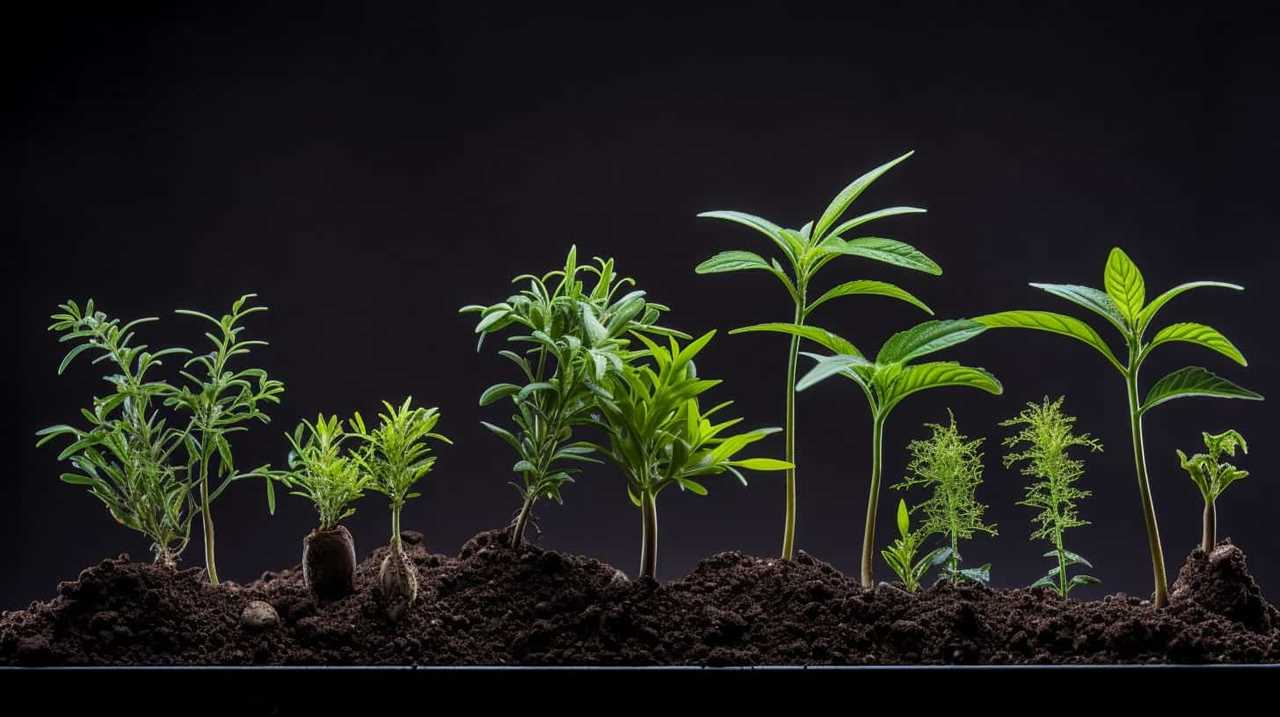
Are you interested in learning about the rich heritage and diverse uses of seeds from Mayan and Aztec cultures?
Well, get ready to embark on a fascinating journey as we delve into the seven historical uses of these incredible seeds.
From their role in food and beverages to their medicinal properties and even their significance in ritual practices, Mayan and Aztec seeds have served a multitude of purposes throughout history.
Join us as we explore the agricultural, nutritional, and cultural importance of these remarkable seeds.
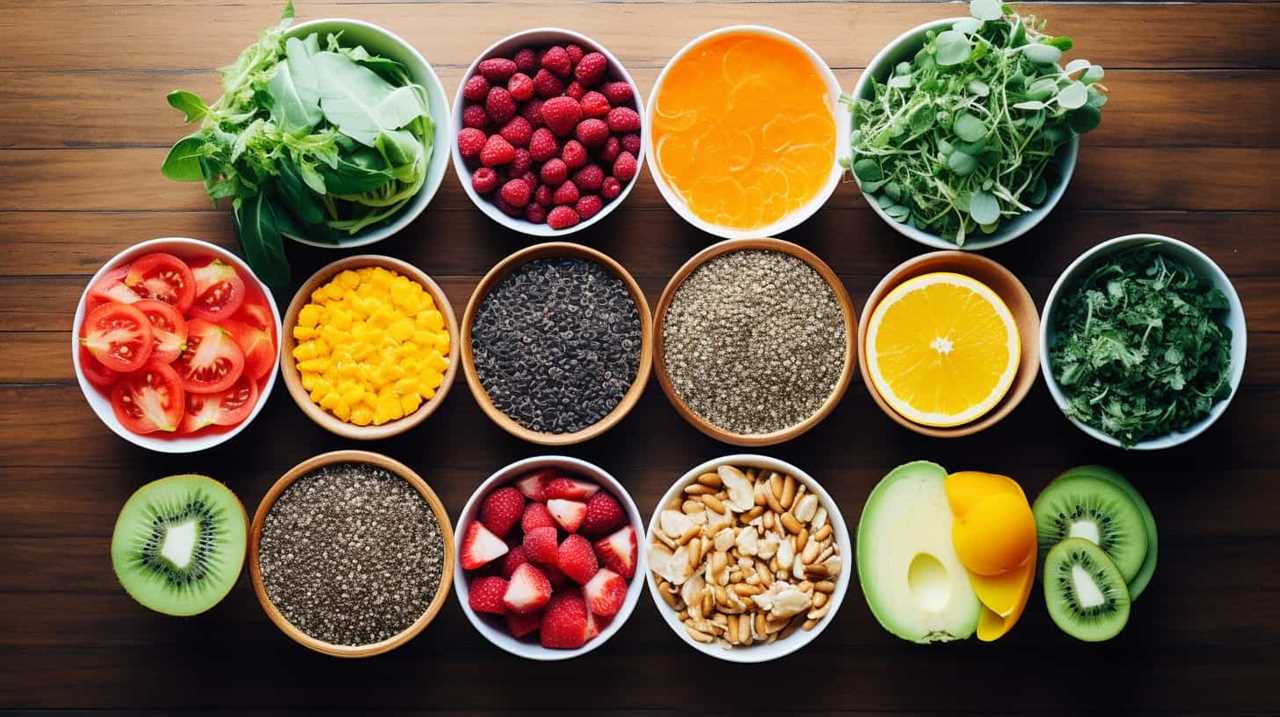
Key Takeaways
- Mayan and Aztec seeds were used in a wide range of traditional recipes, showcasing the ingenuity and creativity of these ancient civilizations.
- These seeds were utilized for their medicinal properties, treating various ailments and reflecting the advanced healthcare knowledge of the Mayans and Aztecs.
- Seeds held significance in shamanic ceremonies and divination practices, used as offerings to the gods and interpreted for guidance into future events.
- Mayan and Aztec seeds were also used in ancient cosmetics, providing benefits for the skin and hair, and promoting sustainable practices in beauty products.
Food and Beverage Applications
One of the most significant uses of Mayan and Aztec seeds was in food and beverage applications, as they provided essential ingredients for nourishment and refreshment.
The culinary innovations of the Mayan and Aztec civilizations incorporated a wide range of seeds into their traditional recipes, resulting in unique and delicious dishes. These seeds weren’t only used for their nutritional value but also for their distinct flavors and textures.
For example, chia seeds were used to make a refreshing beverage called chia fresca, which provided hydration and energy.
Another popular use of seeds was in the preparation of sauces and condiments. Pumpkin seeds were often ground into a paste and combined with other ingredients to create a rich and flavorful sauce.
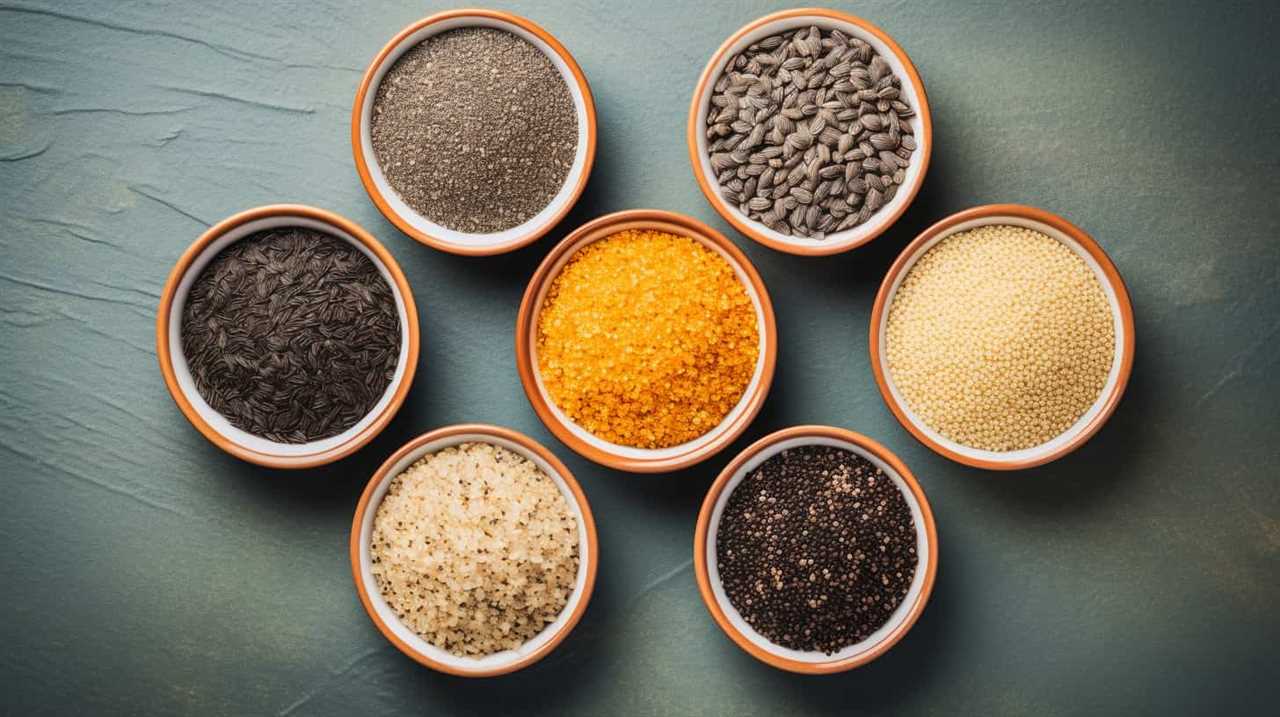
These culinary applications of Mayan and Aztec seeds showcase the ingenuity and creativity of these ancient civilizations in creating nourishing and tasty meals.
Medicinal and Healing Properties
We found that Mayan and Aztec seeds were utilized for their medicinal and healing properties through the application of various traditional remedies. These ancient civilizations recognized the power of nature and relied on the healing properties of seeds to treat various ailments and promote overall well-being.
Traditional remedies involving Mayan and Aztec seeds often involved the use of herbal remedies, which were made from a combination of different seeds and herbs. These remedies were used to address a wide range of health issues, including digestive problems, respiratory conditions, and skin disorders. The Mayans and Aztecs believed in the holistic approach to healing, focusing on treating the root cause of the illness rather than just the symptoms. Their deep understanding of the medicinal properties of seeds demonstrates their advanced knowledge in healthcare.
Transitioning into the subsequent section about ‘ritual and spiritual practices’, we’ll explore how Mayan and Aztec seeds were also used for their significance in rituals and spiritual ceremonies.
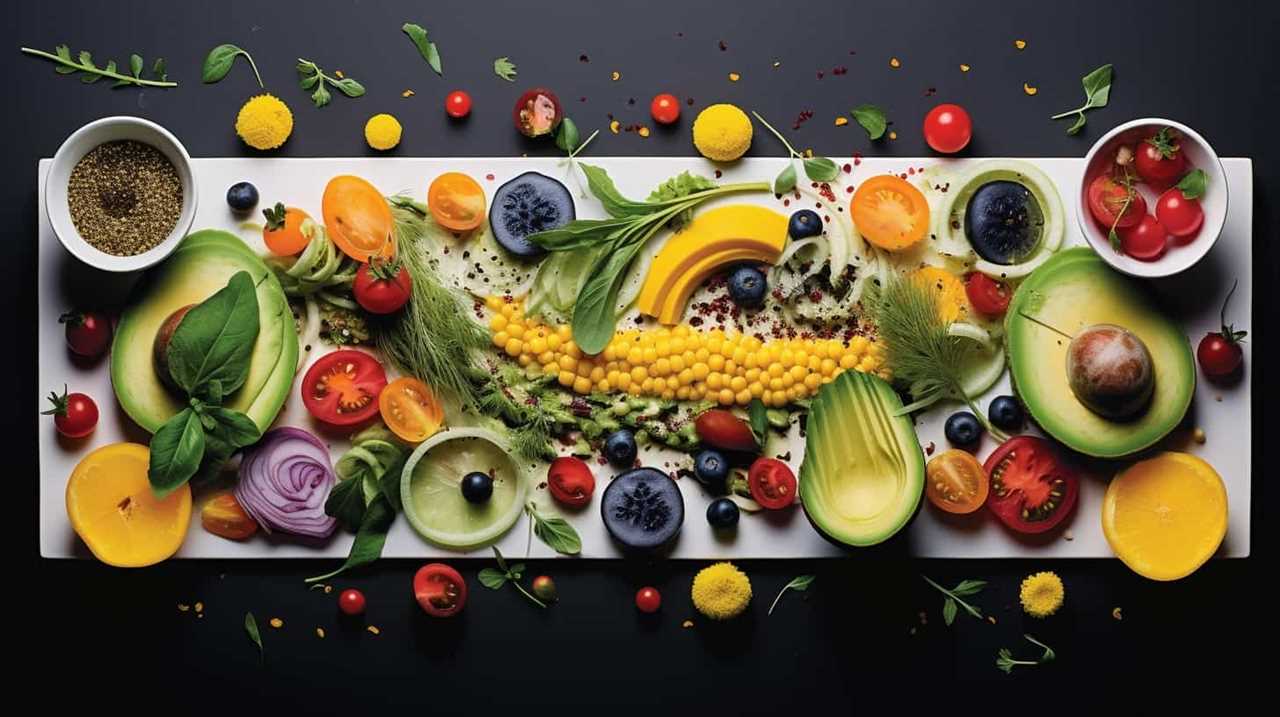
Ritual and Spiritual Practices
Now let’s delve into how we incorporated Mayan and Aztec seeds into our ritual and spiritual practices.
These ancient seeds held immense significance in shamanic ceremonies and divination practices. Our ancestors believed that these seeds had the power to connect us with the spiritual realms and communicate with the divine.
During shamanic ceremonies, the seeds were often used as offerings to the gods, symbolizing our devotion and gratitude. They were also used in divination practices, where they were cast or scattered to gain insight into future events or seek guidance. The seeds were believed to hold hidden messages from the spiritual world, and their patterns and formations were interpreted by skilled practitioners.
Incorporating these seeds into our ritual and spiritual practices allowed us to tap into the sacred wisdom and connect with the spiritual energies that surrounded us.

Cosmetics and Beauty Enhancements
To enhance our beauty, we utilized a variety of Mayan and Aztec seeds in our cosmetics. These seeds weren’t only beneficial for our skin and hair but also played a significant role in cultural preservation.
The Mayans and Aztecs valued sustainable practices, and this translated into the packaging of their beauty products. They used natural materials, such as plant fibers and clay, to create eco-friendly containers that minimized waste and promoted sustainability. This approach of sustainable packaging not only ensured the longevity of their traditions but also showcased their respect for the environment.
Agricultural and Nutritional Importance
Although Mayan and Aztec seeds had significant cultural and cosmetic uses, their agricultural and nutritional importance can’t be overlooked. These seeds played a crucial role in the sustainable farming practices of these ancient civilizations.
The Mayans and Aztecs were highly skilled in cultivating various crops, such as maize, beans, and squash, known as the ‘Three Sisters.’ These crops were interplanted, with each providing unique benefits to the others, promoting soil fertility and reducing the need for pesticides.
Additionally, Mayan and Aztec seeds were highly nutritious, providing essential vitamins, minerals, and dietary fiber. They served as a staple food source, sustaining the population and contributing to their overall health and well-being.
Furthermore, these seeds had economic significance, as they were traded and exported, contributing to the economic prosperity of these civilizations.
Frequently Asked Questions
How Were Mayan and Aztec Seeds Used in Ancient Mayan and Aztec Cuisines?
In ancient Mayan and Aztec cuisines, Mayan and Aztec seeds played a significant role. They were used in various ways, such as adding flavor and texture to dishes, and providing important nutritional benefits to the ancient culinary traditions.
What Are the Potential Health Benefits of Consuming Mayan and Aztec Seeds?
Potential culinary uses of Mayan and Aztec seeds are vast, from adding texture to dishes to enhancing flavors. Scientific research suggests that consuming these seeds may have numerous health benefits, such as improving digestion and boosting nutrient intake.
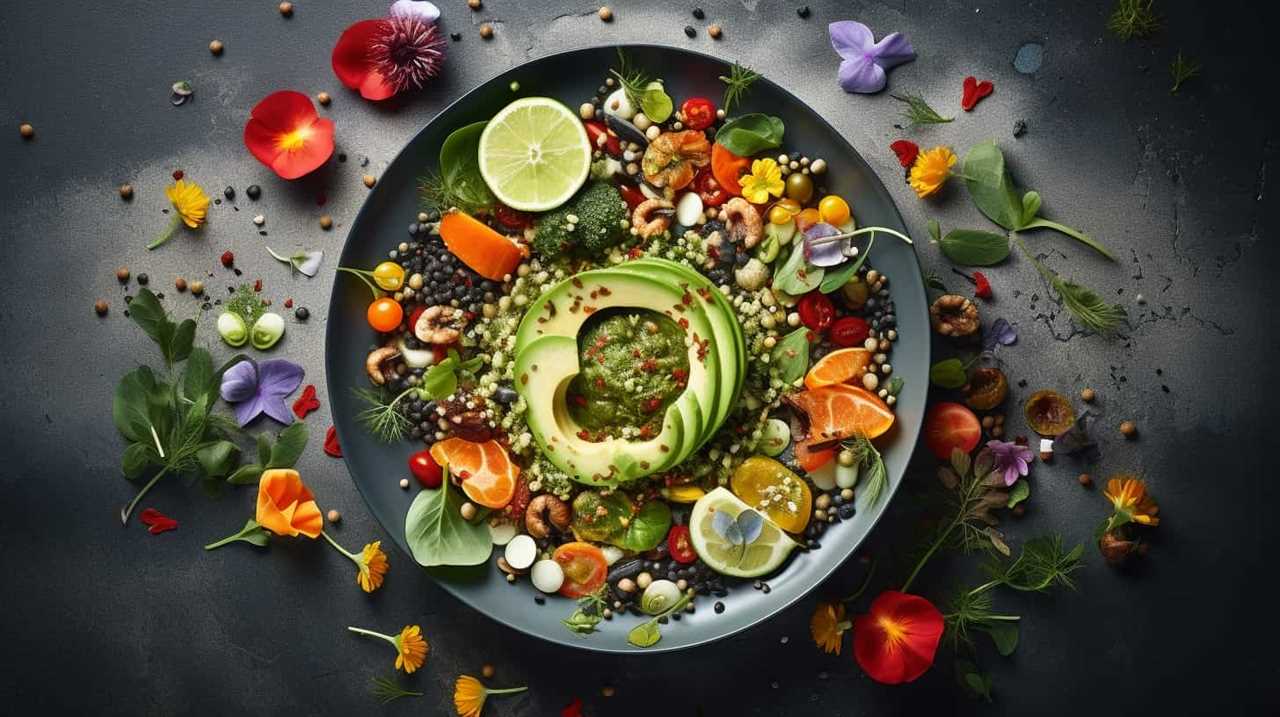
How Were Mayan and Aztec Seeds Incorporated Into Religious Rituals and Ceremonies?
Mayan and Aztec seeds were integral to religious rituals and ceremonies, symbolizing fertility, abundance, and the cycle of life. Seed offerings were made to appease gods and ensure a bountiful harvest.
What Beauty Treatments and Enhancements Were Made Using Mayan and Aztec Seeds?
When it came to beauty treatments and skin care, Mayan and Aztec seeds were truly remarkable. From exfoliating masks to nourishing oils, these seeds were used to enhance our natural beauty and promote healthy, glowing skin.
How Did Mayan and Aztec Civilizations Cultivate and Utilize These Seeds for Nutrition and Agricultural Purposes?
Mayan and Aztec farming techniques involved cultivating and utilizing seeds for nutrition and agricultural purposes. They employed innovative methods to preserve seeds, ensuring a sustainable food supply and contributing to the development of their civilizations.
Conclusion
In conclusion, the historical uses of Mayan and Aztec seeds have proven to be incredibly diverse and significant.

From their role in food and beverage applications to their medicinal properties and spiritual practices, these seeds have played a crucial role in the ancient civilizations.
Additionally, their agricultural and nutritional importance can’t be understated.
Through their exploration and utilization, we’ve discovered a wealth of knowledge and benefits that continue to intrigue and captivate us today.
Hi, I’m Sarah. I write for Turtle Tree Seeds, a news blog that loves food – all kinds of food. But especially bacon, chocolate, and veggies. We’re on a mission to show the world that you can enjoy all of those things, even kale and brussels sprouts. Because we believe that when it comes to food, there’s no such thing as guilty pleasures. Just pleasures.
I’m also a huge fan of puns (obviously).
Historical Use of Chia Seeds
Seeds of Antiquity: A Forgotten Nutritional Powerhouse

Deep within the depths of forgotten history lies a hidden gem waiting to be uncovered – the chia seed. We, the seekers of knowledge, have embarked on a journey to unravel the mysteries of this ancient superfood.
Through the annals of time, chia seeds have nourished civilizations, from the Mayans to the Aztecs, serving as a staple food and a source of sustenance.
Join us as we delve into the traditional uses and fascinating history of these seeds, unlocking their secrets for the benefit of all.
Key Takeaways
- Chia seeds were valued by ancient civilizations like the Egyptians, Chinese, Mayans, and Aztecs for their high nutritional value and health benefits.
- Chia seeds are rich in omega-3 fatty acids, fiber, protein, and antioxidants, and contain essential minerals like calcium, magnesium, and phosphorus.
- Chia seeds have various culinary uses, such as being used as an egg substitute in baking, sprinkled on top of dishes for added crunch, and used as a thickening agent in soups and dressings.
- Chia seeds have a rich cultural heritage and have been used for their medicinal properties throughout history. They are also considered a sustainable crop with a low environmental impact.
Ancient Civilizations and Chia Seeds
We discovered that ancient civilizations prominently utilized chia seeds for their nutritional benefits. In ancient Egypt, chia seeds played a significant role in their diet, providing a rich source of essential nutrients and energy. The Egyptians recognized the remarkable health benefits of chia seeds, incorporating them into their daily meals. These tiny seeds were valued for their high protein content, omega-3 fatty acids, and fiber, which supported digestion and promoted overall well-being.
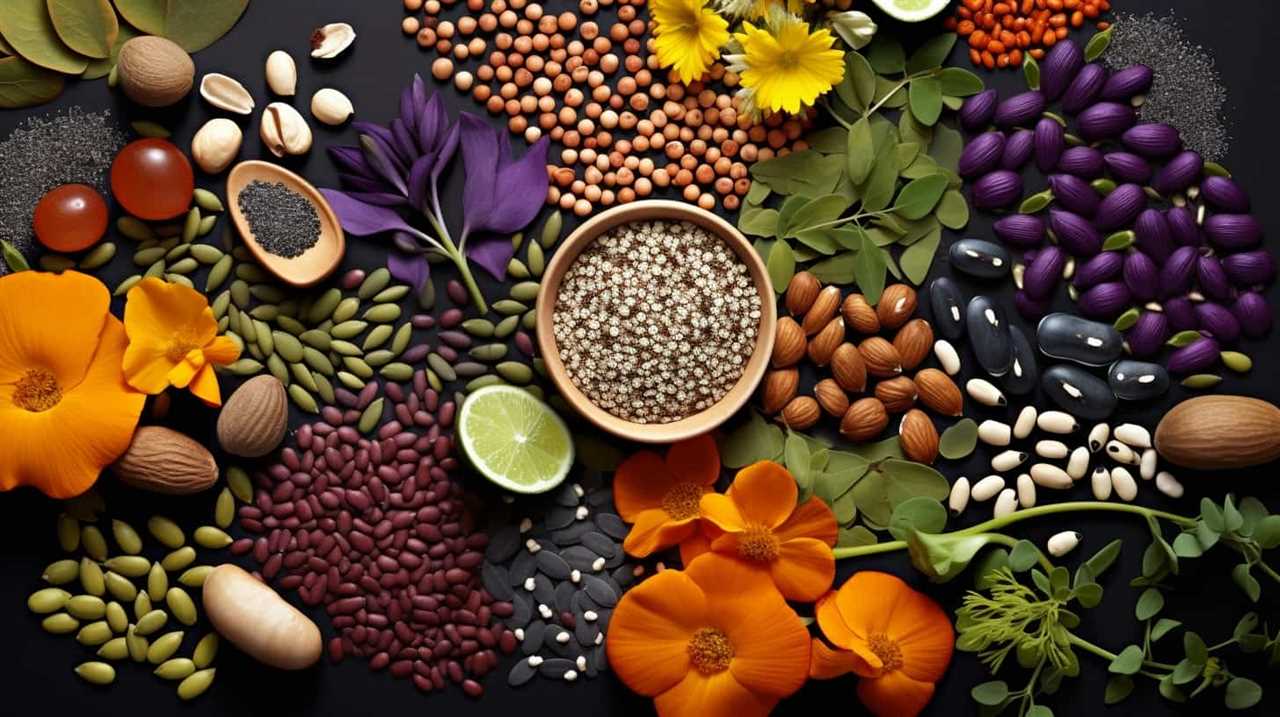
Similarly, in ancient Chinese culture, chia seeds were highly regarded for their medicinal properties. Traditional Chinese medicine recognized the seeds’ ability to nourish the body, improve digestion, and boost vitality. Chia seeds were often used to alleviate digestive issues, reduce inflammation, and enhance cardiovascular health. Their natural antioxidant properties were also utilized to support the immune system and promote longevity.
The ancient civilizations of Egypt and China recognized the immense value of chia seeds, harnessing their nutritional and medicinal properties to serve the well-being of their people. Today, we can continue to benefit from the wisdom of these ancient cultures by incorporating chia seeds into our own diets for optimal health and vitality.
Chia Seeds in Mayan Cuisine
In Mayan cuisine, chia seeds were a staple ingredient, providing a rich source of essential nutrients and contributing to overall health and vitality. Chia seeds were considered one of the Mayan superfoods due to their high nutritional value. These tiny seeds weren’t only abundant in protein, fiber, and healthy fats, but they also contained important vitamins and minerals such as calcium, phosphorus, and magnesium.
Mayans incorporated chia seeds into their meals in various ways. They’d mix the seeds with water or fruit juice, creating a nutritious beverage known as ‘chia fresca.’ Chia seeds were also used as a thickening agent in soups and stews, adding a unique texture and enhancing the nutritional content of the dishes.
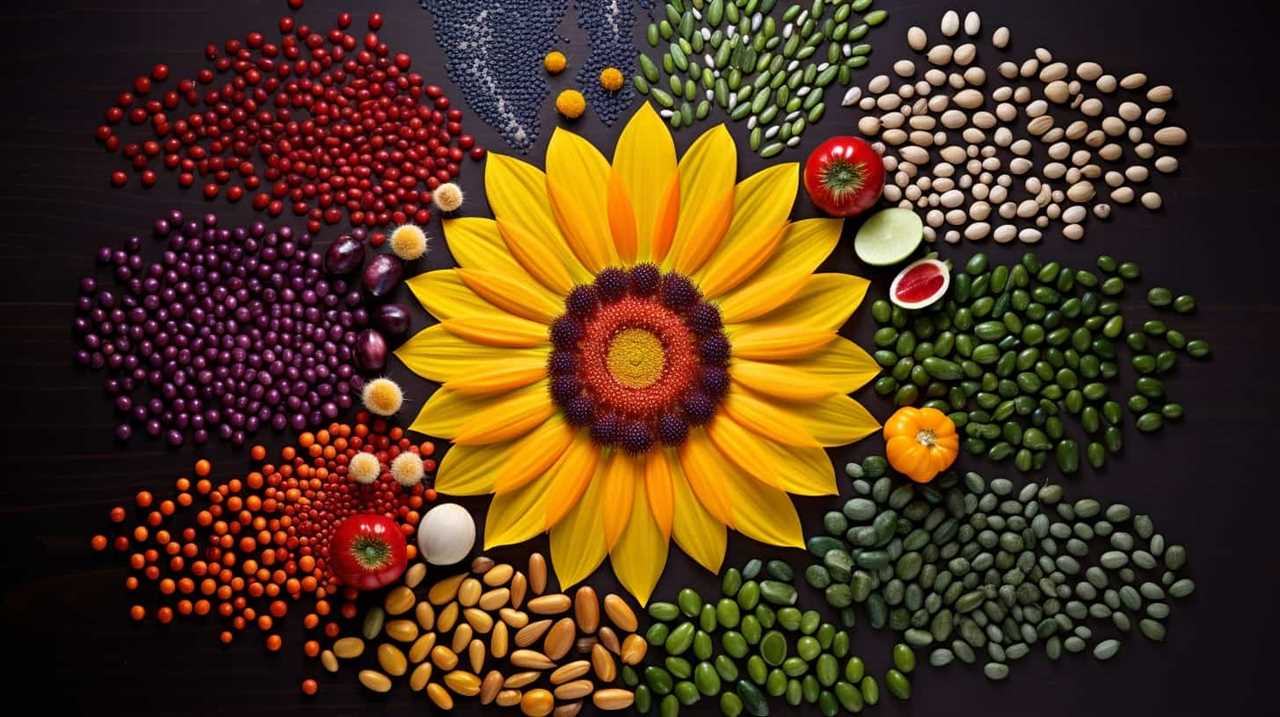
Today, we can still enjoy the benefits of chia seeds by incorporating them into our own recipes for a healthy and fulfilling diet.
Chia Seeds in Aztec Culture
Chia seeds played a significant role in Aztec culture, being widely utilized for their nutritional benefits and incorporated into various aspects of daily life. These Aztec superfoods were highly valued for their ability to provide sustained energy and nourishment.
Here are two ways in which chia seeds were deeply intertwined with Aztec society:
- Culinary Delicacies: Chia seeds were a staple ingredient in Aztec cuisine, used in a variety of dishes such as atole, a thickened beverage, and tamales, a popular corn-based dish. Their gelatinous texture when soaked in water added a unique element to these traditional recipes, enhancing both taste and nutritional value.
- Religious Rituals: Chia seeds held spiritual significance for the Aztecs, often used as offerings in sacred ceremonies. The seeds were believed to possess mystical properties that connected the physical and spiritual realms, symbolizing fertility, abundance, and the cycle of life.
The Aztecs recognized the immense nutritional benefits of chia seeds, incorporating them into their daily lives and embracing their status as an Aztec superfood.
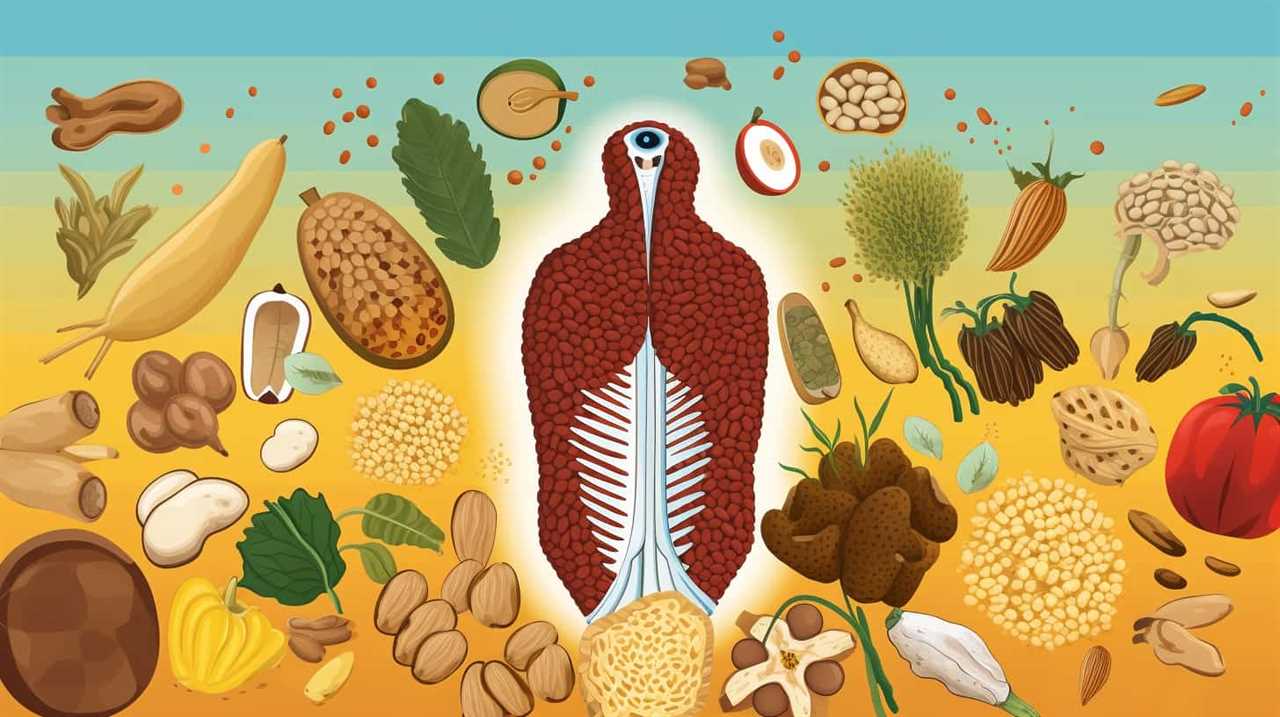
Chia Seeds as a Staple Food
After delving into the role of chia seeds in Aztec culture, we now turn our attention to their significance as a staple food.
Chia seeds have long been recognized for their exceptional nutritional benefits. Packed with omega-3 fatty acids, fiber, protein, and antioxidants, these tiny seeds offer a wealth of health-promoting properties. In fact, chia seeds are considered one of nature’s superfoods due to their high nutrient content. They’ve been associated with improved heart health, digestion, and weight management.
Additionally, chia seeds can be incorporated into a variety of modern recipes, from smoothies and puddings to baked goods and salads. With their mild, nutty flavor, they add a delightful crunch and nutritional boost to any dish.
As we explore the traditional uses of chia seeds, we’ll see how their versatility extends beyond their nutritional value.
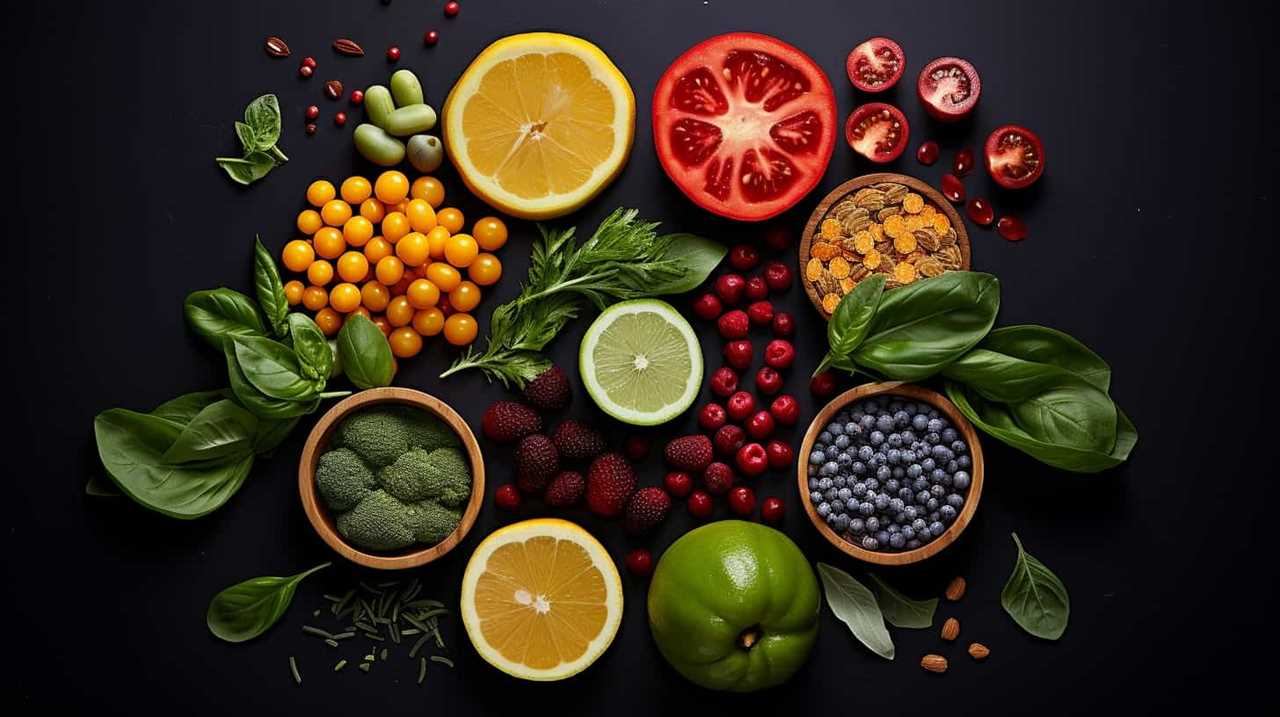
Traditional Uses of Chia Seeds
Our exploration of chia seeds’ traditional uses unveils the myriad ways this nutritional powerhouse has been incorporated into daily life.
Throughout history, chia seeds have been revered for their medicinal properties and have been used in various remedies and treatments. Ancient civilizations believed that chia seeds had the power to heal and strengthen the body, making it a staple in traditional medicine. Today, we continue to harness the medicinal properties of chia seeds in the form of herbal teas, tinctures, and poultices.
Additionally, chia seeds are a versatile ingredient in many recipes, adding a healthy boost of nutrients and a delightful texture. From smoothies and puddings to breads and salads, there are countless chia seed recipes that can be enjoyed as part of a balanced and nourishing diet.
Frequently Asked Questions
Are There Any Side Effects or Potential Risks Associated With Consuming Chia Seeds?
There can be potential risks associated with consuming chia seeds, such as bloating, digestive issues, and allergic reactions. Long term effects of chia seed consumption are still being studied, so it’s important to consume them in moderation.
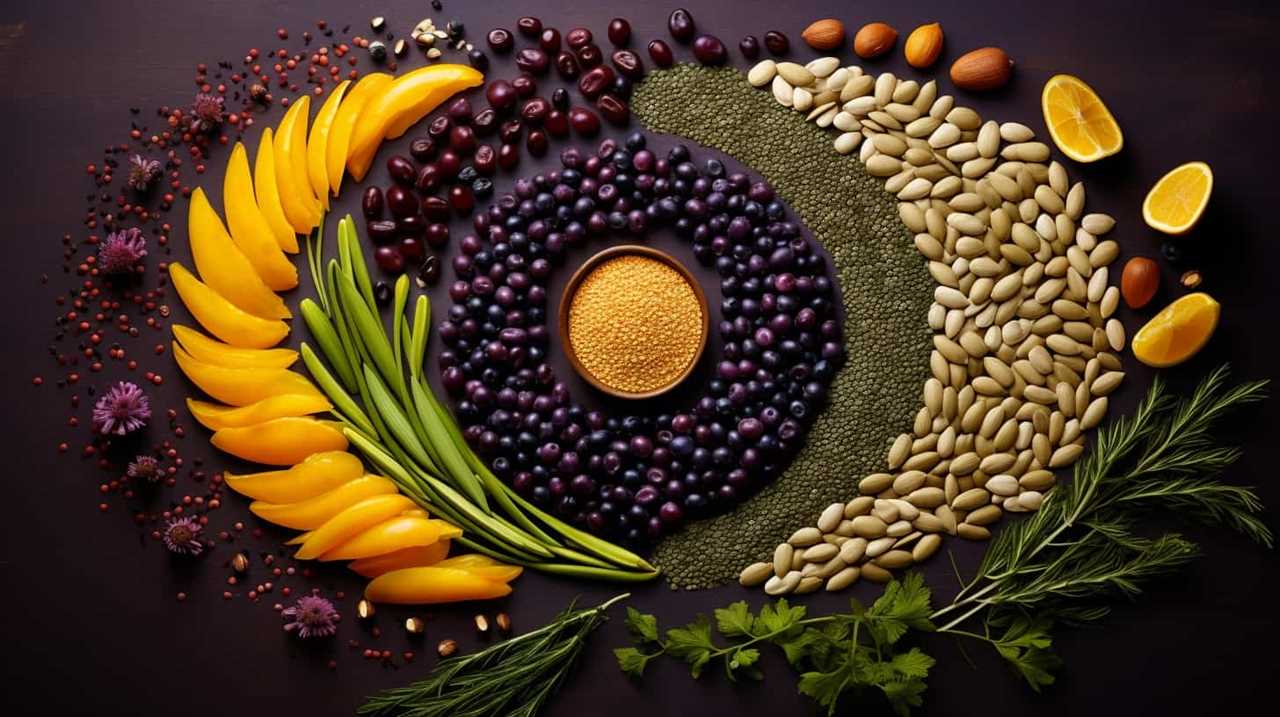
How Can Chia Seeds Be Incorporated Into Modern Diets and Recipes?
Incorporating chia seeds into modern diets can be done in various creative ways. From adding them to smoothies and yogurt to using them as a substitute for eggs in baking, there are endless possibilities for incorporating this nutritional powerhouse into your daily meals.
What Is the Nutritional Content of Chia Seeds and How Do They Compare to Other Superfoods?
Chia seeds are a nutritional powerhouse, offering a wide range of health benefits. Compared to flaxseeds, they provide more omega-3 fatty acids, making them an excellent plant-based source. Incorporating chia seeds into our diets can greatly improve our overall well-being.
Can Chia Seeds Aid in Weight Loss or Provide Other Health Benefits?
Chia seeds can aid in weight loss and provide various health benefits. They impact digestion and gut health by promoting regularity and reducing inflammation. They also improve cardiovascular health by lowering cholesterol and blood pressure.
Where Can I Buy Chia Seeds and Are There Different Varieties Available?
We can find chia seeds at various stores and online retailers. There are different types of chia seeds available, such as black and white. Let’s explore the buying options and the varieties in more detail.
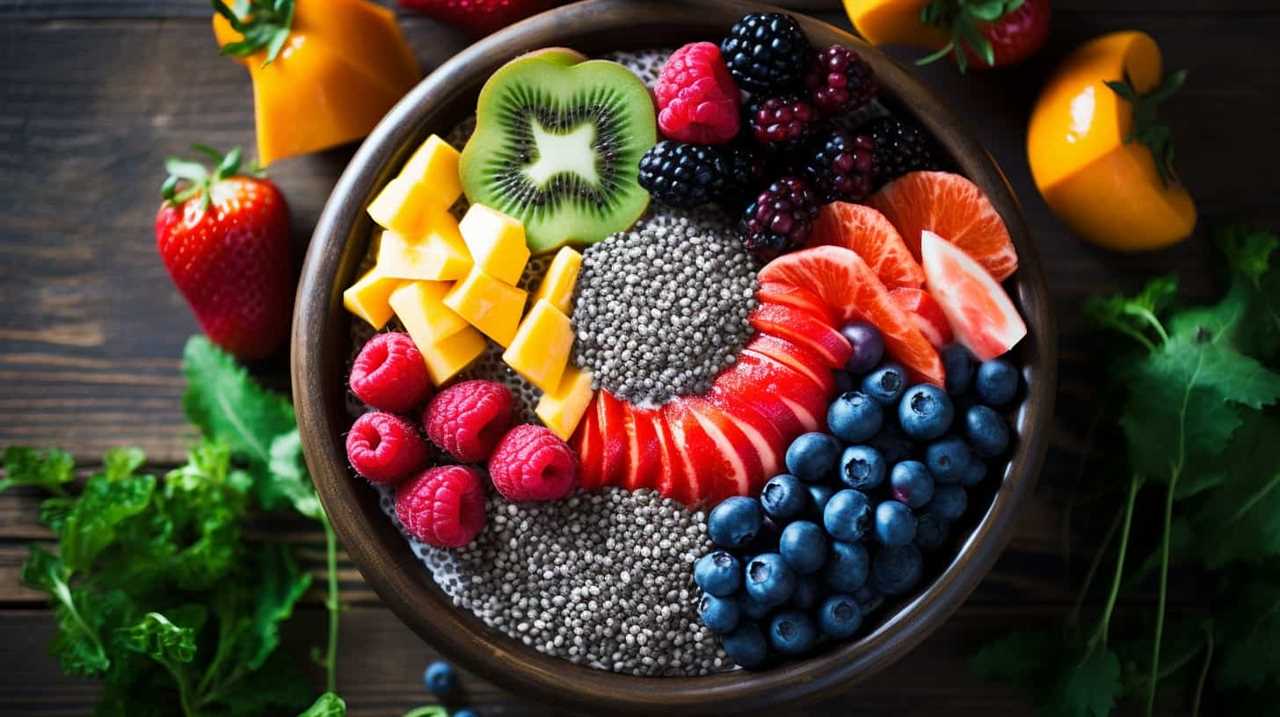
Conclusion
In conclusion, chia seeds have long been a nutritional powerhouse in ancient civilizations such as the Mayans and Aztecs. Despite their small size, these seeds were a staple food due to their high nutrient content and numerous health benefits.
While some may argue that chia seeds are just a trendy superfood, their historical significance and traditional uses prove otherwise. Incorporating chia seeds into our modern diets can provide us with a rich source of essential nutrients and contribute to our overall well-being.
Hi, I’m Sarah. I write for Turtle Tree Seeds, a news blog that loves food – all kinds of food. But especially bacon, chocolate, and veggies. We’re on a mission to show the world that you can enjoy all of those things, even kale and brussels sprouts. Because we believe that when it comes to food, there’s no such thing as guilty pleasures. Just pleasures.
I’m also a huge fan of puns (obviously).
Historical Use of Chia Seeds
80% of Traditional Medicine Relied on Seed Power

Here is some fascinating information for you: did you know that an incredible 80% of traditional medicine relied on the power of seeds? Yes, these tiny wonders were crucial in ancient healing practices.
In this article, we’ll delve into the historical use and medicinal properties of chia seeds, exploring how they were utilized in traditional remedies. Get ready to discover the incredible seed power that shaped ancient medicine!
Key Takeaways
- Chia seeds were highly valued in ancient healing practices for their medicinal properties.
- Traditional medicine recognized the nutritional benefits of chia seeds, including omega-3 fatty acids, fiber, protein, antioxidants, calcium, and magnesium.
- Chia seeds were used to promote digestive health, increase stamina and endurance, and retain moisture in the body.
- Seeds, including chia seeds, played a crucial role in traditional medicine and were recognized for their diverse healing properties and contribution to overall well-being.
Historical Use of Chia Seeds
One of the main historical uses of chia seeds was their incorporation into the diets of indigenous cultures for their nutritional benefits. Chia seeds have a long-standing history as a staple food in various cultures, including the Aztecs and Mayans. These seeds were highly valued for their culinary uses and nutritional benefits.
The Aztecs used chia seeds in a variety of dishes, including beverages, porridge, and bread. They believed that chia seeds provided them with sustained energy and endurance.

The nutritional benefits of chia seeds are impressive. They’re packed with essential nutrients, such as omega-3 fatty acids, fiber, protein, and antioxidants. Chia seeds are also gluten-free and can be easily incorporated into a variety of recipes.
Traditional Medicinal Properties of Chia Seeds
Exploring the historical use of chia seeds, we uncover their traditional medicinal properties that have been relied upon for generations. Chia seeds aren’t only a rich source of essential nutrients, but they also possess several medicinal benefits. Here are four key traditional medicinal properties of chia seeds:
- Nutritional benefits: Chia seeds are packed with omega-3 fatty acids, fiber, protein, antioxidants, and minerals like calcium and magnesium. These nutrients contribute to overall health and well-being.
- Digestive aid: Chia seeds are known to promote healthy digestion and prevent constipation. The high fiber content helps regulate bowel movements and maintain a healthy gut.
- Energy booster: Chia seeds are a great source of sustained energy. They provide a slow release of carbohydrates, keeping you energized throughout the day.
- Anti-inflammatory properties: Chia seeds contain antioxidants that help reduce inflammation in the body. This can benefit individuals with conditions like arthritis or inflammatory bowel disease.
In addition to their traditional uses, chia seeds have found modern applications in various forms such as smoothies, puddings, and baked goods. They’re also used in vegan cooking as a substitute for eggs.
Chia Seeds in Ancient Healing Practices
We continue to uncover the historical use of chia seeds by exploring their role in ancient healing practices. Chia seeds were highly valued for their medicinal properties and were widely used in various ancient healing practices. These tiny seeds were believed to have healing powers and were used to treat a range of ailments.

To give you a clearer picture, here is a table depicting the popularity of chia seeds in ancient healing practices:
| Ancient Healing Practices | Chia Seeds Popularity |
|---|---|
| Traditional Chinese Medicine | Highly regarded for their ability to tonify the kidneys and replenish vital energy. |
| Ayurveda | Considered a cooling and soothing herb used for digestive disorders and as a general tonic. |
| Mayan Medicine | Used to promote hydration, improve endurance, and aid in digestion and assimilation of nutrients. |
| Native American Healing | Valued for their high nutritional content and as a source of sustained energy. |
| Ancient Greek Medicine | Recognized for their anti-inflammatory properties and as a remedy for joint pain. |
Chia seeds were a staple in ancient healing practices, and their popularity can be attributed to their versatile and beneficial properties. They were revered for their ability to support overall health and well-being, making them an integral part of traditional medicine.
Role of Chia Seeds in Traditional Remedies
Continuing our exploration of chia seeds in ancient healing practices, it’s important to understand their role in traditional remedies. Chia seeds have long been regarded as a superfood due to their nutritional value and health benefits. In traditional remedies, chia seeds were used for their medicinal properties and culinary applications.
Here are four ways chia seeds played a significant role in traditional remedies:
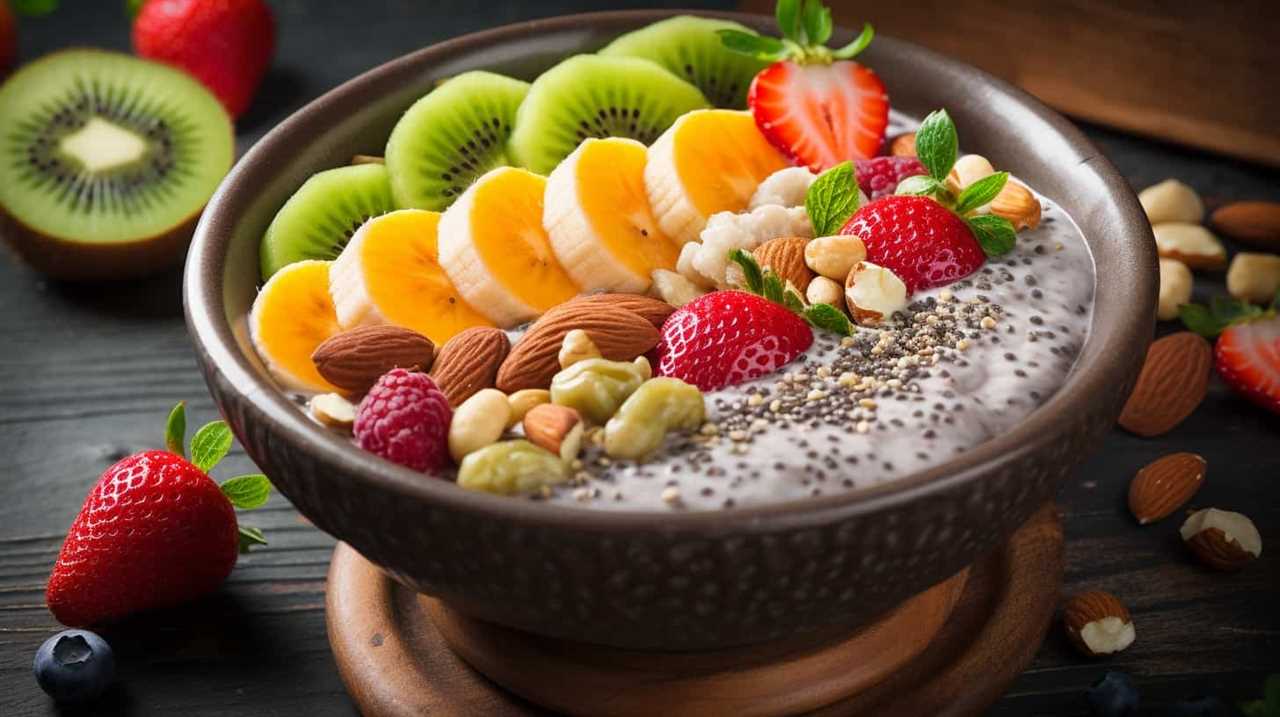
- Digestive health: Chia seeds were used to alleviate digestive issues such as bloating, indigestion, and constipation. Their high fiber content helped regulate bowel movements and promote a healthy gut.
- Energy booster: Chia seeds were consumed to increase stamina and endurance. They provided a sustainable source of energy due to their rich nutrient profile, including omega-3 fatty acids, protein, and antioxidants.
- Hydration aid: Chia seeds were soaked in water to create a gel-like substance that helped retain moisture in the body. This was especially beneficial in hot climates or during physical exertion.
- Nutritional supplement: Chia seeds were added to various dishes and beverages to enhance their nutritional value. They provided essential vitamins, minerals, and antioxidants, contributing to overall wellness.
Incorporating chia seeds into traditional remedies showcased their versatility and effectiveness in promoting health and well-being. With their superfood status and culinary applications, chia seeds continue to be recognized for their beneficial properties in modern times.
Seed Power in Traditional Medicine
Moving forward in our exploration of chia seeds in traditional healing practices, it’s important to delve into the significant role of seed power in traditional medicine.
Seed power, which refers to the therapeutic properties of seeds, has been utilized for centuries in various cultures around the world.
In modern medicine, seed-based remedies are gaining recognition for their numerous health benefits. Seeds contain essential nutrients, such as vitamins, minerals, and antioxidants, which promote overall well-being and help prevent diseases. Furthermore, these remedies are often natural and plant-based, making them a safe and sustainable option for those seeking alternative treatments.

Incorporating seed power into traditional medicine allows for a holistic approach to healing, addressing the root cause of ailments and supporting the body’s natural healing processes.
Frequently Asked Questions
Are There Any Potential Side Effects or Risks Associated With Consuming Chia Seeds for Medicinal Purposes?
Potential side effects and risks associated with consuming chia seeds for medicinal purposes include digestive issues and allergic reactions. It is important to consume them in moderation and follow recommended dosage guidelines to minimize any potential adverse effects.
How Were Chia Seeds Traditionally Prepared and Consumed in Ancient Healing Practices?
In ancient healing practices, chia seeds were prepared and consumed in various ways, reflecting their cultural significance in traditional medicine. These methods of chia seed preparation held deep-rooted beliefs in their healing properties and nourishing benefits.
Are There Any Modern Scientific Studies or Research That Support the Traditional Medicinal Properties of Chia Seeds?
Modern scientific studies on chia seeds have shown promising results regarding their efficacy in traditional medicine. These studies provide evidence supporting the medicinal properties of chia seeds, validating their use in ancient healing practices.
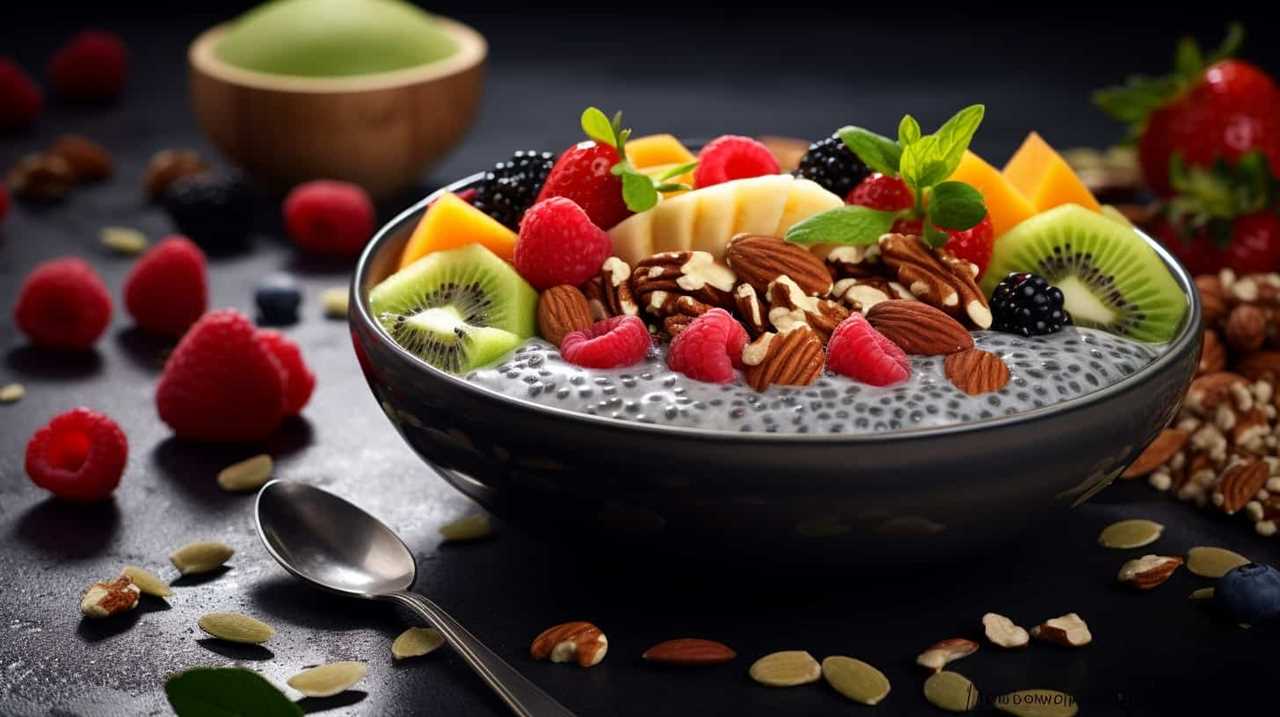
What Other Traditional Remedies or Healing Practices Commonly Used Chia Seeds as a Key Ingredient?
Traditional remedies using chia seeds include recipes for healing teas and poultices. Their effectiveness has been supported by anecdotal evidence, but more research is needed. In modern medicine, research on chia seeds is ongoing, exploring their potential applications in various health conditions.
Can Chia Seeds Be Used as a Standalone Remedy or Should They Be Combined With Other Herbs or Ingredients for Maximum Effectiveness in Traditional Medicine?
Chia seeds can be used as a standalone remedy, but for maximum effectiveness in traditional medicine, they are often combined with other herbs or ingredients. This combination enhances their healing properties and overall health benefits.
Conclusion
In conclusion, chia seeds have played a significant role in traditional medicine, with 80% of remedies relying on their powerful properties. From boosting energy levels to aiding digestion, these tiny seeds have been valued for their medicinal benefits for centuries.
For example, imagine a woman struggling with chronic inflammation who incorporates chia seeds into her diet. Over time, she experiences a reduction in pain and improved overall health, thanks to the healing power of these seeds.

Hi, I’m Sarah. I write for Turtle Tree Seeds, a news blog that loves food – all kinds of food. But especially bacon, chocolate, and veggies. We’re on a mission to show the world that you can enjoy all of those things, even kale and brussels sprouts. Because we believe that when it comes to food, there’s no such thing as guilty pleasures. Just pleasures.
I’m also a huge fan of puns (obviously).
Historical Use of Chia Seeds
Age-old Healing Secrets of Tiny Powerhouse Seeds

We have unlocked the ancient healing powers of tiny, powerful seeds. These tiny wonders have been cherished and used by early civilizations for centuries. From the Mayans to Traditional Chinese Medicine, chia seeds have played a key role in improving overall health and wellness.
With their myriad of health benefits, it’s no wonder they continue to be revered in Ayurveda and Native American healing traditions. Join us as we delve into the fascinating world of these ancient seeds and unlock their incredible healing potential.
Key Takeaways
- Chia seeds have been valued for their medicinal properties in various ancient cultures such as Egyptian, Greek, Roman, Chinese, Ayurvedic, Native American, and Mayan.
- Chia seeds offer numerous nutritional benefits, including being rich in omega-3 fatty acids, dietary fiber, antioxidants, protein, and vitamins and minerals.
- Chia seeds possess energy-boosting properties that enhance endurance, provide sustained energy release, fuel the body with carbohydrates, combat fatigue, increase mental alertness, and promote hydration.
- Chia seeds have a wide range of traditional and modern uses, from grinding them into flour and using them as toppings, to adding them to smoothies, using them as an egg substitute, sprinkling them on salads, using them as thickening agents, and more.
Ancient Civilizations and Chia Seeds
We discovered that ancient civilizations relied on chia seeds as a powerful source of nutrition and healing. Chia seeds weren’t only a staple food in ancient Egyptian medicine but also played a significant role in Greek and Roman healing practices.
In ancient Egypt, chia seeds were recognized for their ability to provide sustained energy, making them a vital ingredient in the diet of pharaohs and warriors. Meanwhile, in Greek and Roman cultures, chia seeds were highly valued for their medicinal properties, believed to aid in digestion, reduce inflammation, and promote overall wellness. These ancient civilizations recognized the immense nutritional value of chia seeds and harnessed their healing potential.
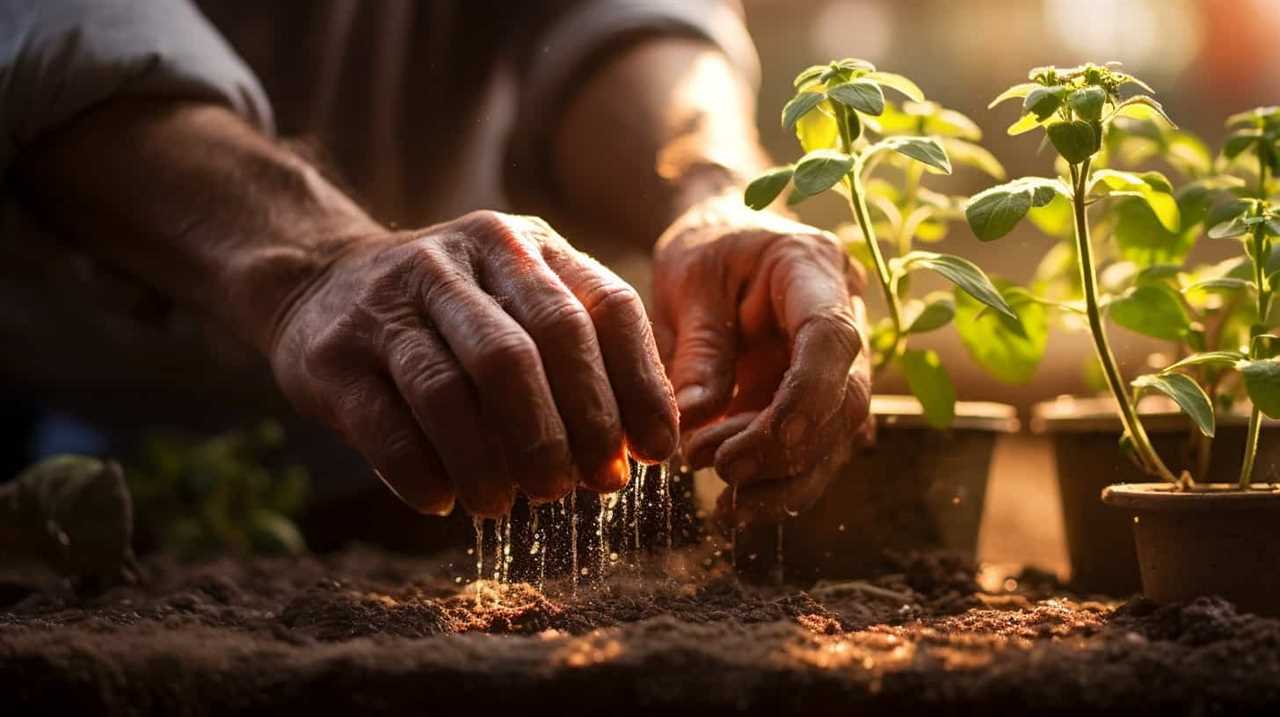
As we delve further into the topic, let’s explore the role of chia seeds in traditional Chinese medicine and uncover the secrets behind their continued relevance throughout history.
Chia Seeds in Traditional Chinese Medicine
Moving on to the role of chia seeds in Traditional Chinese Medicine, we continue to uncover their healing potential and the ways in which they’ve been utilized throughout history. Chia seeds have long been recognized for their numerous healing properties in Chinese medicine. Here are three ways in which chia seeds have been traditionally used:
- Yin and Yang balance: Chia seeds are believed to have a harmonizing effect on the body’s yin and yang energies. They’re thought to help restore balance and promote overall well-being.
- Digestive health: Chia seeds have been used to support digestion and relieve digestive ailments such as bloating and constipation. They’re known for their high fiber content, which aids in digestion.
- Blood sugar regulation: Chia seeds have been used to help regulate blood sugar levels. Their gel-like consistency can slow down the conversion of carbohydrates into sugar, preventing spikes in blood sugar levels.
In modern times, chia seeds are still valued for their healing properties and are commonly used in various forms such as in smoothies, puddings, and baked goods. Their versatility and nutritional benefits make them a popular choice for those seeking to improve their overall health and well-being.
Chia Seeds in Ayurveda
Continuing our exploration of chia seeds’ healing potential, let’s delve into their role in Ayurveda.
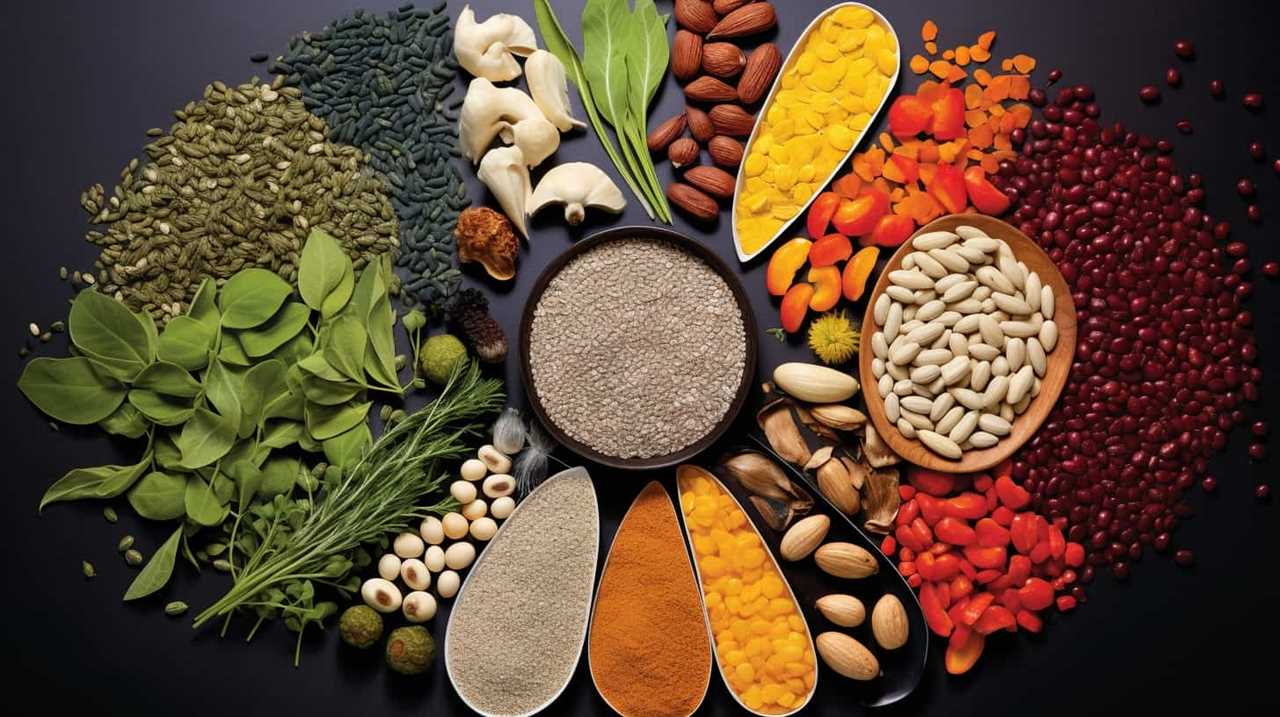
Chia seeds have been recognized for their Ayurvedic properties, making them a valuable addition to modern wellness trends. In Ayurveda, chia seeds are considered to have a cooling effect on the body, which helps balance Pitta dosha, responsible for digestion and metabolism.
These seeds are also known to be nourishing and grounding, making them beneficial for Vata dosha, associated with movement and creativity. Chia seeds are rich in fiber, omega-3 fatty acids, and antioxidants, making them a nutritious addition to a healthy diet.
They can support digestion, promote healthy skin, and help maintain overall well-being. Incorporating chia seeds into your daily routine can be a simple and effective way to embrace Ayurvedic principles and enhance your wellness journey.
Native American Healing Traditions and Chia Seeds
Let’s explore the role of chia seeds in Native American healing traditions. Native American healing practices have a rich history of using natural remedies to promote health and well-being. Chia seeds have been a part of these traditions for centuries, valued for their healing properties and nutritional benefits.

Here are three key ways in which chia seeds have been incorporated into Native American healing practices:
- Chia seeds as a source of energy and sustenance: Native Americans recognized the high nutrient content of chia seeds, using them as a source of sustained energy during long journeys and periods of physical exertion.
- Chia seeds for digestive health: Native American healing traditions have long recognized the digestive benefits of chia seeds. They were often used to soothe digestive discomfort and promote healthy digestion.
- Chia seeds for hydration: Chia seeds have the ability to absorb and retain water, making them a valuable tool for maintaining hydration. Native Americans would prepare a chia gel by soaking the seeds in water, which would then be consumed to support hydration.
With their numerous healing properties, chia seeds have played a vital role in Native American healing practices.
Now, let’s delve into their significance in ancient Mayan culture.
Chia Seeds in Ancient Mayan Culture
Chia seeds also held significant importance in the ancient Mayan culture, as they were valued for their healing properties and nutritional benefits. The Mayans were known for their advanced agricultural practices, and they cultivated chia seeds as one of their superfoods. These tiny seeds provided a rich source of essential nutrients, including omega-3 fatty acids, fiber, protein, and antioxidants.
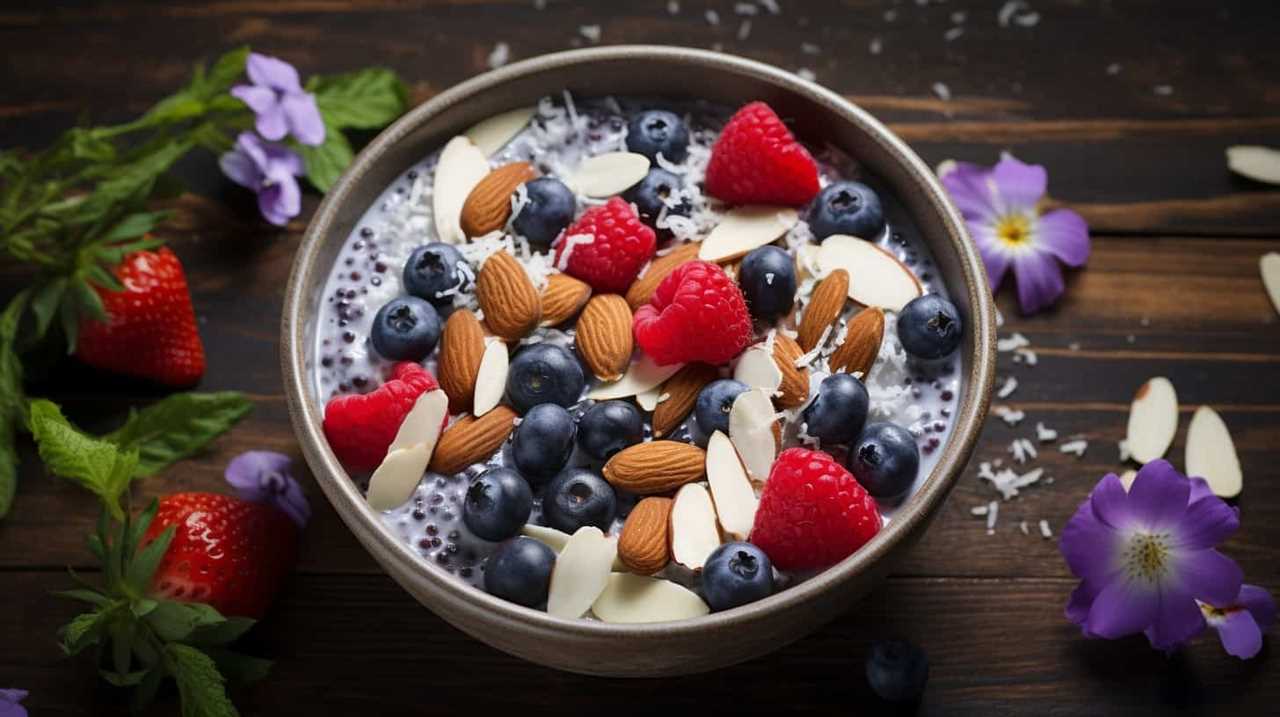
The Mayans recognized the power of chia seeds to improve endurance, boost energy levels, and support overall health and well-being. They incorporated chia seeds into their diet by grinding them into flour, mixing them with water to create a gel-like substance, or using them as a topping for various dishes.
Today, we can still benefit from the Mayan wisdom by including chia seeds in our own diets, enjoying the same healing and nutritional advantages that they recognized centuries ago.
Frequently Asked Questions
How Can Chia Seeds Be Incorporated Into Modern Western Diets?
We’ve found some great chia seed recipes and meal ideas for picky eaters. Incorporating chia seeds into modern western diets is easy and beneficial, both for our health and the environment. Let us show you how!
Are There Any Potential Side Effects or Allergies Associated With Consuming Chia Seeds?
Potential side effects and allergies associated with consuming chia seeds include digestive issues and allergic reactions. It is important to start with small quantities, drink plenty of water, and consult a healthcare professional if you have any concerns.
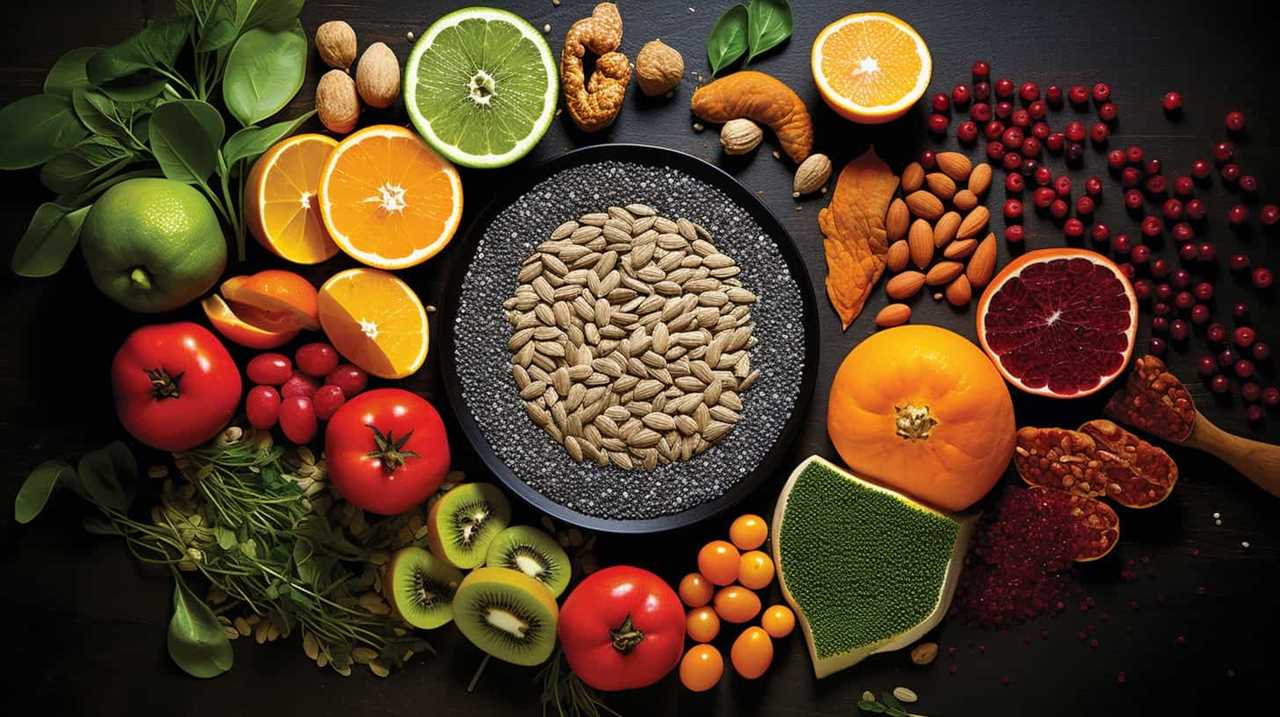
Can Chia Seeds Be Used as a Natural Remedy for Specific Health Conditions?
Chia seeds have been used for centuries to support health and well-being. They may have potential benefits for diabetes management and weight loss, but it’s important to consult with a healthcare professional for personalized advice.
Are There Any Specific Guidelines or Recommended Daily Amounts for Consuming Chia Seeds?
There are recommended daily amounts for consuming chia seeds, which can provide numerous health benefits. It’s important to follow these guidelines to maximize the positive effects on our well-being.
Are There Any Known Interactions Between Chia Seeds and Medications or Other Supplements?
We should be aware of potential drug interactions and possible adverse effects when consuming chia seeds. It’s important to consult with a healthcare professional to ensure the safe and optimal use of medications and supplements.
Conclusion
In conclusion, the healing secrets of chia seeds have been passed down through ancient civilizations and traditional healing practices. From the Mayans to the Chinese and Ayurveda, these tiny powerhouse seeds have been revered for their holistic and evidence-based healing properties.

Whether you incorporate them into your diet or explore their use in alternative medicine, chia seeds offer a natural and nutrient-rich solution for overall health and well-being.
Hi, I’m Sarah. I write for Turtle Tree Seeds, a news blog that loves food – all kinds of food. But especially bacon, chocolate, and veggies. We’re on a mission to show the world that you can enjoy all of those things, even kale and brussels sprouts. Because we believe that when it comes to food, there’s no such thing as guilty pleasures. Just pleasures.
I’m also a huge fan of puns (obviously).
-
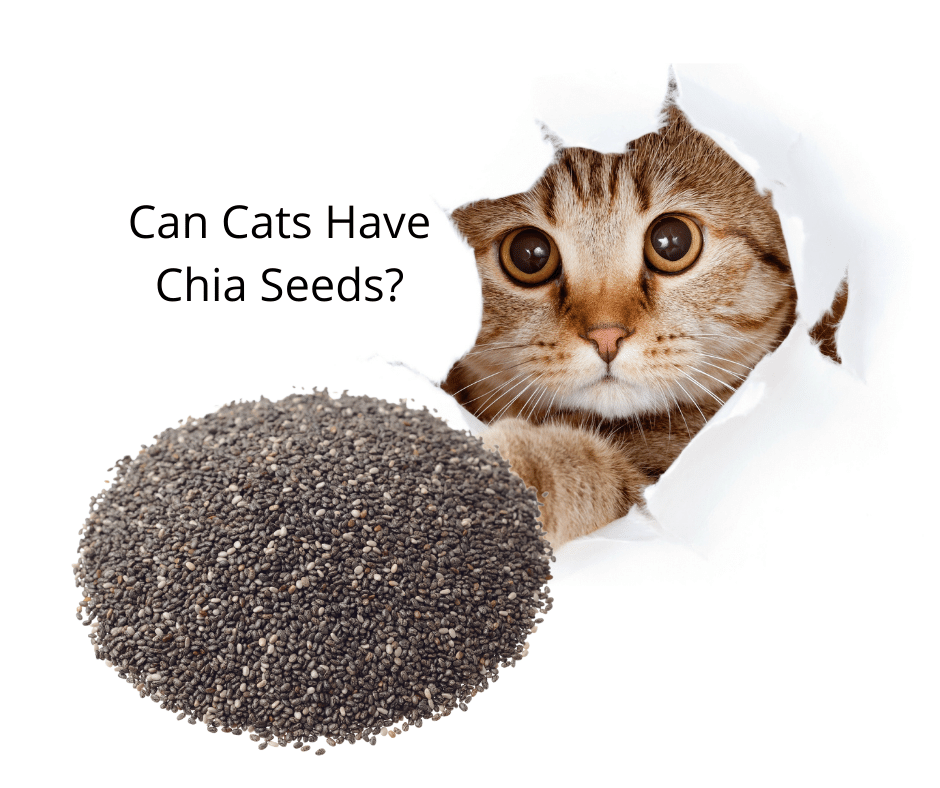
 Chia Seeds3 months ago
Chia Seeds3 months agoCan Cats Have Chia Seeds?
-
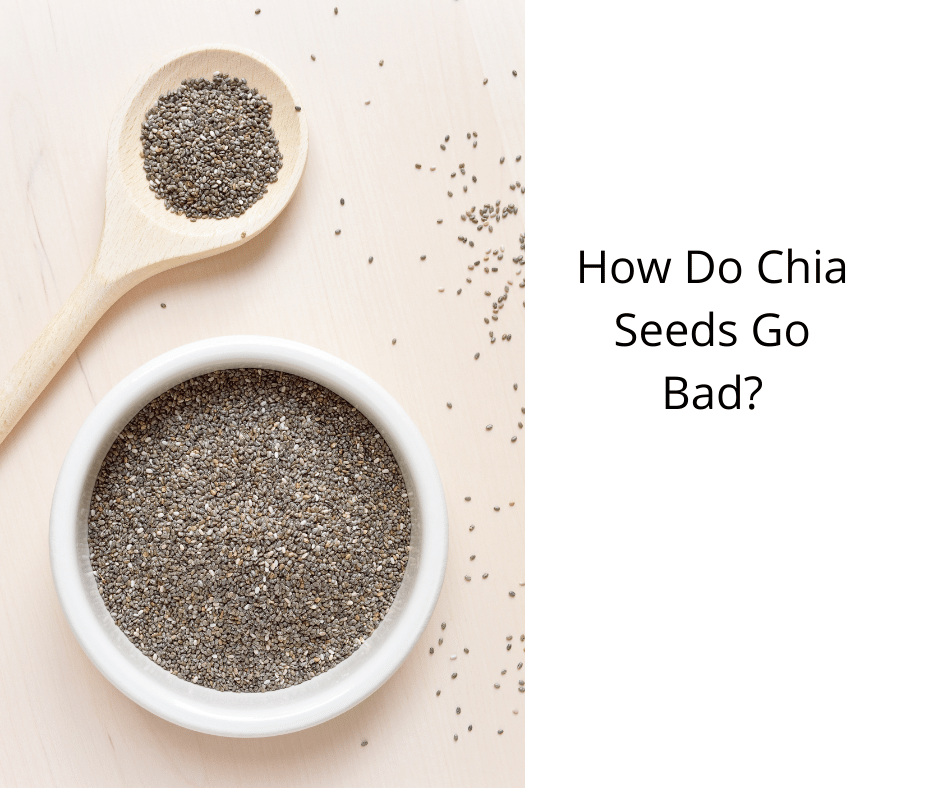
 Chia Seeds3 months ago
Chia Seeds3 months agoHow Do Chia Seeds Go Bad?
-

 Chia Seeds3 months ago
Chia Seeds3 months agoDo Chia Seeds Make You Poop?
-

 Health Risks and Allergies Related to Chia Seeds3 months ago
Health Risks and Allergies Related to Chia Seeds3 months agoWhy Do Chia Seeds Gel
-

 Chia Seeds3 months ago
Chia Seeds3 months agoHow to Use Chia Seeds For Weight Loss
-

 Chia Seeds and Digestive Health2 weeks ago
Chia Seeds and Digestive Health2 weeks agoWhy Are Chia Seeds Beneficial For Gut Health?
-
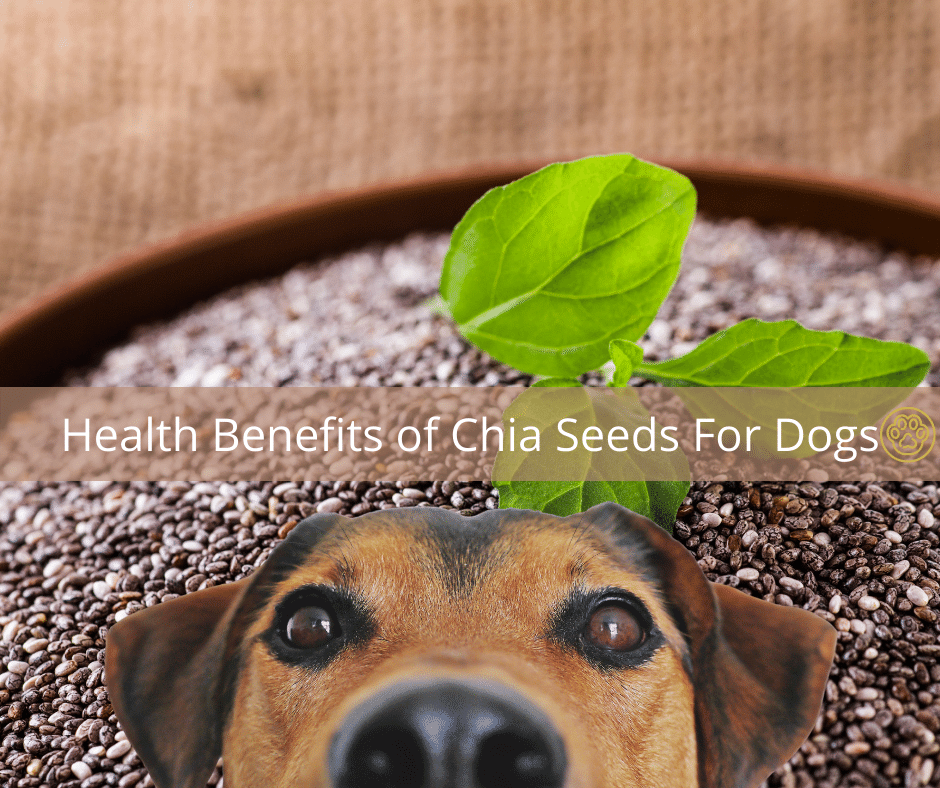
 Chia Seeds3 months ago
Chia Seeds3 months agoHealth Benefits of Chia Seeds For Dogs
-

 Chia Seeds in Gluten-Free Diets2 months ago
Chia Seeds in Gluten-Free Diets2 months agoYour Dependable Guide: Chia as a Gluten Substitute






